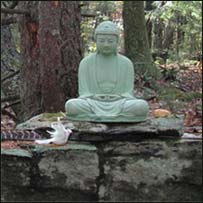|
|
 |
Please support Dharma Seed with a 2025 year-end gift.
Your donations allow us to offer these teachings online to all.

|

|

|
The greatest gift is the
gift of the teachings
|
|

|
| |
|
Dharma Talks
|
2021-11-11
Letting Your Heartbreak Open to Active Hope
53:05
|
|
James Baraz
|
|
|
How can we keep open and stay engaged when our hearts are breaking and we just want to shut down? How can we cultivate a "no-matter-what commitment" as Terry Patten teaches? How can we develop "Active Hope" as Joanna Macy calls it. That is the topic of this week's exploration. The talk includes a powerful 20-minute conversation between Joanna Macy and Thanissara that took place a month before this recording.
|
|
Insight Meditation Community of Berkeley
|
|
|
2021-11-10
Fear and Love
59:40
|
|
Tara Brach
|
|
|
Only when we face our fears can we discover the freedom to love without holding back. This talk looks at how unprocessed fear contracts our body, heart and mind, and on a societal level is the cause of othering and violence. We then explore how arousing mindfulness, compassion and prayer can enlarge our basic sense of Being. As we deepen attention to the nature of awareness, we discover a refuge that is timeless…a refuge that is our true home.
|
|
Insight Meditation Community of Washington DC
|
|
|
2021-11-10
Mother Trees, Our Elders
43:25
|
|
Betsy Rose
|
|
|
The Buddha famously taught that the Sangha is the most important aspect of “the Holy Life”. And Indigenous wisdom (and recent biology) teach us that natural systems are also a sangha, a web of connection, kept healthy by reciprocity and generosity.
Betsy reflects on the dharma of the “Mother Trees”, and how elders (and youth) feed the life of our human ecosystem.
|
|
Assaya Sangha
|
|
|
2021-11-07
Introduction to Awakened Awareness
63:37
|
|
Donald Rothberg
|
|
|
In concentration practice and insight practice, some of the structures of ordinary experience are deconstructed, including the separation of knower and known, the solidity of the object, and the will (which is absent in choiceless awareness). We then explore the nature of awakened awareness with references to how this appears in the teachings of the Buddha, the Thai Forest tradition, and the Tibetan Dzogchen and Mahamudra traditions. Finally, some of the main accessing techniques to open to awakened awareness are described.
|
|
Spirit Rock Meditation Center
:
Settling, Seeing, and Luminous Awareness
|
|
|
2021-11-05
Unsurpassed Is the Protection of the Dhamma
22:59
|
|
Ayya Medhanandi
|
|
|
Impermanence stares us in the face. How then can we free ourselves to understand the raw truth of what we are? There is a sorrowless state, a way out of the pains of life where we can abide in blameless happiness and inviolable peace. It may appear elusive and out of reach. Yet we need only incline our minds faithfully to giving up all that is false, divisive, fearful or fragile. We begin to know the joy that subdues all sorrow. One taste of that and we are on the Path, sheltered in the unsurpassed protection of the Dhamma.
|
|
Ottawa Buddhist Society
|
|
|
2021-11-04
Showing Up for Reality with Humility and Grace:
Terry Patten's Last Teaching
50:16
|
|
James Baraz
|
|
|
Beloved Philosopher, Teacher and Sacred Activist Terry Patten sadly passed away a few days before this talk. His last book, A New Republic of the Heart, is an inspiring teaching on how to face the global crises we are in. As he went through his own final journey he shared how one can face death with courage, wonder, grace and trust. It was a blueprint for how to meet the pain and sorrow of the world with those same qualities. This talk includes a powerful, clear, deeply moving clip excerpt of Terry's last teaching a week before he passed plus some of his teachings that have touched so many.
|
|
Insight Meditation Community of Berkeley
|
|
|
2021-11-04
Noble Giving Means Giving Oneself
58:18
|
|
Ajahn Sucitto
|
|
|
The quality of dāna, giving, is not dependent on materiality or even a charitable obligation. It’s a Dhamma practice that makes you stronger than you thought you were – it brings up your nobility. It’s a privilege to give because it makes you glad, and so the enlightenment factors arise in the mind. For the one receiving, giving brings forth integrity – one wants to live up to the offering. This is the dāna principle; everybody wins. This dāna is a step on the Path to awakening.
|
|
Cittaviveka
|
|
|
|
|